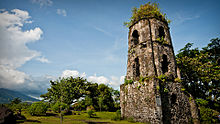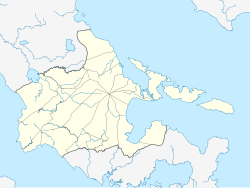Rugba nin Cagsawa | |
 Only the church tower and the walls remains the Cagsawa Church, which was destroyed by the 1814 eruption of Mayon Volcano | |
| Alternative name | Kagsawa, Cagsaua |
|---|---|
| Location | Barangay Busay, Daraga, Albay, Bicol Region, Philippines |
| Coordinates | 13°9′58″N 123°42′4″E / 13.16611°N 123.70111°E |
| Type | Church |
| Area | 500 m2 (5,400 sq ft) |
| History | |
| Builder | Franciscan order |
| Founded | 1724 |
| Abandoned | 1814 |
| Management | Local government of Daraga and the National Museum of the Philippines |
The Cagsawa Ruins (also spelled as Kagsawa, historically spelled as Cagsaua) are the remnants of a 16th-century Franciscan church, the Cagsawa church. It was originally built in the town of Cagsawa in 1587 but was burned down and destroyed by Dutch pirates in 1636. It was rebuilt in 1724 by Fr. Francisco Blanco but was destroyed again, along with the town of Cagsawa, on February 1, 1814, during the eruption of Mayon Volcano.
The ruins are currently located in Barangay Busay, Cagsawa, in the municipality of Daraga, Albay, Philippines. It is part of Cagsawa Park, is protected and maintained by the municipal government of Daraga and the National Museum of the Philippines, and is one of the most popular tourist destinations in the area. The Internationale Tourismus-Börse Berlin, one of the world's top travel trade shows based in Berlin, has even recognized the site as one of the places to visit in Asia.[1] A preliminary excavation of the Cagsawa ruins by the Bulacan State University, show that the Spanish incorporated Mesoamerican influences in constructing the complex.[2]
- ^ "ITB Berlin". Messe Berlin. Retrieved May 3, 2014.
- ^ Preliminary Results of Archaeological Investigation in Cagsawa Ruins in Albay, Philippines: Sacred Spaces Archaeology By: Angel Sarmiento Recto, Reynaldo Ramos Avellana, Evangelina Ramos Recto (Page 13)


